Your Guide to China’s E-commerce: Current Insights and Essential Entry Strategies

E-commerce, defined as business transactions conducted via the internet, is playing an increasingly crucial role in the modern economy. With ongoing technological advancements and changing consumer shopping habits, e-commerce has become a mainstream global business model. In China, the rapid growth of the e-commerce market has not only altered consumer shopping behaviors but also propelled the overall economic development. This article delves into the definition of e-commerce, analyzes the current state of China’s e-commerce development, and offers practical strategies for entering the Chinese e-commerce market.
What is E-commerce?
E-commerce refers to the buying and selling of goods and services over the internet, encompassing a variety of business models, including:
- B2B (Business to Business): Transactions conducted between businesses online, exemplified by platforms like Alibaba.
- B2C (Business to Consumer): Direct sales of goods and services from businesses to consumers, as seen on platforms like JD.com and Tmall.
- C2C (Consumer to Consumer): Individuals trade goods and services directly with each other through online platforms, such as Taobao and Xianyu.
The primary components of e-commerce encompass online retail, payment systems, and logistics and delivery. Together, these elements create a comprehensive e-commerce ecosystem that facilitates convenient and efficient shopping experiences for consumers.

The Current State of E-commerce in China
Market Size
In 2023, the Chinese e-commerce market reached a staggering 50.57 trillion RMB (approximately 2.2 trillion USD), reflecting a 6.31% increase from 47.57 trillion RMB in 2022. This solidifies China’s status as the world’s largest e-commerce market. Online retail sales in China amounted to 15.42 trillion RMB, marking an 11% growth and maintaining its leadership in the global online retail sector for 11 consecutive years. The share of physical goods in online retail has risen to a record 27.6% of total retail sales of consumer goods, underscoring the robust growth and vast potential of China’s e-commerce landscape.
Major E-commerce Platforms
Prominent e-commerce platforms in China include Taobao, JD.com, and Pinduoduo. These platforms not only provide a diverse array of products but also engage a vast consumer base through innovative marketing strategies. Intense competition among these platforms drives the continuous introduction of new features aimed at enhancing user experience and satisfaction.

Emerging E-commerce Models: Live Streaming and Social E-commerce
In recent years, innovative models such as live streaming and social e-commerce have rapidly gained traction in China, becoming key drivers of e-commerce growth. Live streaming e-commerce fosters real-time interaction, encouraging impulse purchases, while social e-commerce utilizes social media platforms to promote products, enhancing user engagement and the overall shopping experience. These new business models have not only introduced fresh growth opportunities for traditional e-commerce but have also enabled brands to forge deeper connections with consumers.
By 2021, the user base of China’s social e-commerce industry reached 850 million, representing a significant portion of the total online shopping population. According to iResearch, the market size of Chinese social e-commerce grew to 2.76 trillion RMB in 2022, reflecting a year-on-year increase of 9.17%. Despite a slowdown in growth rate, social e-commerce continues to represent a promising niche market.
Key social e-commerce platforms in China include Douyin and Xiaohongshu, each with distinct features that attract large user bases and capture significant market shares:
- Douyin: This short-video platform is deeply integrated with e-commerce, employing tactics such as live stream selling. In 2023, Douyin’s e-commerce sales are projected to reach 363 billion USD, a considerable portion of total social e-commerce sales.
- Xiaohongshu: A content-driven platform, has attracted a large number of young consumers through user-generated content (UGC) and community interaction. As more brands adopt the “seeding and harvesting” marketing strategy on Xiaohongshu, they have achieved rapid business growth. Xiaohongshu is increasingly establishing a strong influence in areas such as beauty and fashion, with its market share continuing to grow.

The Rise of Cross-border E-commerce
As globalization continues to deepen, the scale of China’s cross-border e-commerce imports and exports has expanded significantly, emerging as a vital driver of foreign trade. An increasing number of Chinese brands are utilizing cross-border e-commerce platforms to access global markets, delivering quality products to consumers around the world. Leading platforms in China’s cross-border e-commerce landscape include AliExpress, TEMU, and SHEIN.

How to Enter China’s E-commerce Market?
As globalization continues to deepen, the scale of China’s cross-border e-commerce imports and exports has expanded significantly, emerging as a vital driver of foreign trade. An increasing number of Chinese brands are utilizing cross-border e-commerce platforms to access global markets, delivering quality products to consumers around the world. Leading platforms in China’s cross-border e-commerce landscape include AliExpress, TEMU, and SHEIN.
- Understanding Market Demands: Conducting thorough research on target consumer groups, including their shopping habits, preferences, and pain points, is essential for crafting effective market entry strategies. The rising demand for personalized and convenient shopping experiences necessitates adjustments in product offerings and services.
- Choosing the Right Platform: Selecting the most appropriate e-commerce platform based on product type is critical. For example, Xiaohongshu and Douyin may be more suitable for fashion and beauty products, while Taobao and JD.com are better suited for everyday consumer goods. Each platform has its distinct user base and marketing strategies, which brands should align with their positioning.
- Optimizing Localization Strategies: Tailoring brand messaging, product descriptions, and customer support to align with local cultural and language preferences can significantly enhance user experience and satisfaction.
- Utilizing Social Media Marketing: In China, social media is intricately linked with e-commerce. Through KOL (Key Opinion Leader) / influencer marketing and content marketing, brands can effectively enhance their visibility and sales conversion rates.
By factoring in these key considerations, you’re equipped with initial preparations to enter China’s e-commerce market. Strengthen your strategy with our AI Attribute Discovery and Multi-Attribute Sentiment Analysis to pinpoint consumer preferences and ensure a laser-focused market entry. Contact us today and let AI insights power your success.
Future Outlook
Chinese e-commerce maintains a leading position in the global market, with its vast potential and innovative capabilities laying a solid foundation for future growth. In a market environment characterized by both opportunities and challenges, overseas and Hong Kong businesses should proactively seize the advantages presented by the digital economy to strategically navigate the future e-commerce landscape, aiming for sustainable growth.
Unlock your brand’s potential and drive growth on Chinese e-commerce platforms with our tailored E-commerce Entry Solutions. Our expert consulting services guarantee a successful market entry, optimizing traffic and sales strategies for you. Contact Tocanan today and let us help your business thrive!
